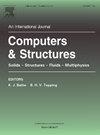An adaptive multi-task learning method for response prediction and optimal sensor placement
IF 4.8
2区 工程技术
Q1 COMPUTER SCIENCE, INTERDISCIPLINARY APPLICATIONS
引用次数: 0
Abstract
Accurate and effective structural vibration response prediction is a fundamental yet challenging task in engineering. Despite extensive research endeavors, reliable multi-objective response prediction remains largely unexplored, which is due to two significant challenges: difficulties in sensor position selection and unbalanced response prediction across different tasks. To address these issues, an unbalanced sparse multi-task response prediction based on feature selection (USMuRFS) approach is proposed, which bridges the gap between predictive modeling and optimal sensor placement. Specifically, an adaptive multi-task prediction framework is designed, integrated with a sparsity-guided variable selection module to identify trustworthy sensors and multi-objective response prediction simultaneously. The innovative design of USMuRFS embodies two main aspects: first, USMuRFS incorporates an adaptive loss balancing module that encourages fair optimization of each sub-objective within the prediction tasks; second, a hybrid penalty is introduced to select sensors at the group-sparsity, individual-sparsity, and element-sparsity levels. These two components, i.e., the adaptive loss balancing module and sparsity regularized module, contribute to each other and constitute USMuRFS together. Experiments on synthetic datasets, standard aircraft models, and large commercial aircraft flight test datasets illustrate that USMuRFS distinctly outperforms previous approaches. This can provide reliable insights into optimal sensor placement in multi-task response prediction.
基于自适应多任务学习的响应预测与传感器优化配置方法
准确有效的结构振动响应预测是工程领域的一项基础而又具有挑战性的任务。尽管进行了广泛的研究,但可靠的多目标响应预测仍未得到充分的探索,这主要是由于两个重大挑战:传感器位置选择困难和不同任务之间的响应预测不平衡。为了解决这些问题,提出了一种基于特征选择的非平衡稀疏多任务响应预测(USMuRFS)方法,该方法弥补了预测建模和最优传感器放置之间的差距。具体而言,设计了一个自适应多任务预测框架,结合稀疏引导变量选择模块,同时识别可信传感器和多目标响应预测。USMuRFS的创新设计主要体现在两个方面:首先,USMuRFS引入了自适应损失平衡模块,鼓励在预测任务中公平优化每个子目标;其次,引入混合惩罚来选择群体稀疏度、个体稀疏度和元素稀疏度级别的传感器。自适应损失均衡模块和稀疏正则化模块这两个组成部分相互作用,共同构成USMuRFS。在合成数据集、标准飞机模型和大型商用飞机飞行测试数据集上的实验表明,USMuRFS明显优于以前的方法。这可以为多任务响应预测中的最佳传感器放置提供可靠的见解。
本文章由计算机程序翻译,如有差异,请以英文原文为准。
求助全文
约1分钟内获得全文
求助全文
来源期刊

Computers & Structures
工程技术-工程:土木
CiteScore
8.80
自引率
6.40%
发文量
122
审稿时长
33 days
期刊介绍:
Computers & Structures publishes advances in the development and use of computational methods for the solution of problems in engineering and the sciences. The range of appropriate contributions is wide, and includes papers on establishing appropriate mathematical models and their numerical solution in all areas of mechanics. The journal also includes articles that present a substantial review of a field in the topics of the journal.
 求助内容:
求助内容: 应助结果提醒方式:
应助结果提醒方式:


